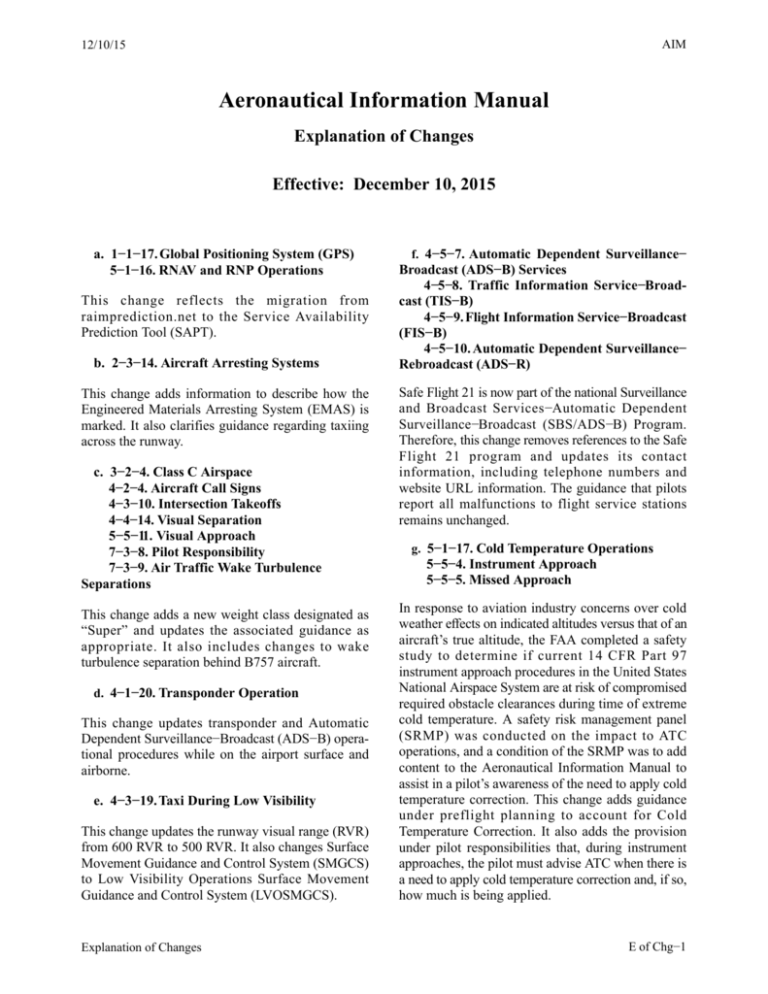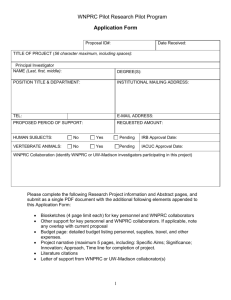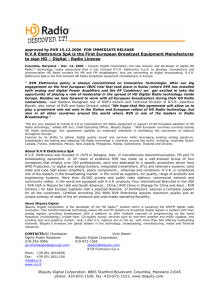Aeronautical Information Manual
advertisement

AIM 12/10/15 Aeronautical Information Manual Explanation of Changes Effective: December 10, 2015 a. 1−1−17. Global Positioning System (GPS) 5−1−16. RNAV and RNP Operations This change reflects the migration from raimprediction.net to the Service Availability Prediction Tool (SAPT). b. 2−3−14. Aircraft Arresting Systems This change adds information to describe how the Engineered Materials Arresting System (EMAS) is marked. It also clarifies guidance regarding taxiing across the runway. c. 3−2−4. Class C Airspace 4−2−4. Aircraft Call Signs 4−3−10. Intersection Takeoffs 4−4−14. Visual Separation 5−5−11. Visual Approach 7−3−8. Pilot Responsibility 7−3−9. Air Traffic Wake Turbulence Separations This change adds a new weight class designated as “Super” and updates the associated guidance as appropriate. It also includes changes to wake turbulence separation behind B757 aircraft. d. 4−1−20. Transponder Operation This change updates transponder and Automatic Dependent Surveillance−Broadcast (ADS−B) opera­ tional procedures while on the airport surface and airborne. e. 4−3−19. Taxi During Low Visibility This change updates the runway visual range (RVR) from 600 RVR to 500 RVR. It also changes Surface Movement Guidance and Control System (SMGCS) to Low Visibility Operations Surface Movement Guidance and Control System (LVOSMGCS). Explanation of Changes f. 4−5−7. Automatic Dependent Surveillance− Broadcast (ADS−B) Services 4−5−8. Traffic Information Service−Broad­ cast (TIS−B) 4−5−9. Flight Information Service−Broadcast (FIS−B) 4−5−10. Automatic Dependent Surveillance− Rebroadcast (ADS−R) Safe Flight 21 is now part of the national Surveillance and Broadcast Services−Automatic Dependent Surveillance−Broadcast (SBS/ADS−B) Program. Therefore, this change removes references to the Safe Flight 21 program and updates its contact information, including telephone numbers and website URL information. The guidance that pilots report all malfunctions to flight service stations remains unchanged. g. 5−1−17. Cold Temperature Operations 5−5−4. Instrument Approach 5−5−5. Missed Approach In response to aviation industry concerns over cold weather effects on indicated altitudes versus that of an aircraft’s true altitude, the FAA completed a safety study to determine if current 14 CFR Part 97 instrument approach procedures in the United States National Airspace System are at risk of compromised required obstacle clearances during time of extreme cold temperature. A safety risk management panel (SRMP) was conducted on the impact to ATC operations, and a condition of the SRMP was to add content to the Aeronautical Information Manual to assist in a pilot’s awareness of the need to apply cold temperature correction. This change adds guidance under preflight planning to account for Cold Temperature Correction. It also adds the provision under pilot responsibilities that, during instrument approaches, the pilot must advise ATC when there is a need to apply cold temperature correction and, if so, how much is being applied. E of Chg−1 12/10/15 AIM h. 5−2−2. Pre−Departure Clearance Procedures The Terminal Data Link System has been upgraded to include Controller Pilot Data Link Communication Clearance (CPDLC)-Departure Clearance (DCL) messaging. The content and title have been updated to reflect this automation. i. 5−2−8. Instrument Departure Procedures (DP) − Obstacle Departure Procedures (ODP) and Standard Instrument Departures (SID) 5−5−14. Instrument Departures This change clarifies previous guidance regarding visual climb over airport (VCOA) and aligns it with the definition provided in the Pilot/Controller Glossary. It also adds the requirement that pilots advise ATC when they intend to fly the VCOA procedure as early as possible prior to departure. j. 5−4−5. Instrument Approach Procedure Charts This change updates the description of minimum safe altitudes (MSA) based on conventional navigation systems and RNAV. It allows for the use of the airport reference point as the center of an MSA for conventional navigation systems. This change also updates the chart note and clarifies what is expected from the pilot when the procedures visual descent angle (VDA) is removed. E of Chg−2 k. 5−4−14. Parallel ILS Approaches (Depend­ ent) This change introduces the use of 1 mile radar separation diagonally on simultaneous dependent approaches when runway centerlines are separated by at least 2,500 feet but no more than 3,600 feet. The existing paragraph is revised to account for the new 3,600 foot standard. There are no additional conditions or procedures required when utilizing the 1 NM minimum separation standard. l. 9−1−4. General Description of Each Chart Series Appendix 3. Abbreviations/Acronyms This change is updated to reflect that the last edition of the World Aeronautical Chart (WAC) will be published in March 2016. Current WAC editions will be effective through the previously published effective date(s). As such, all references to WAC have been deleted. m. Pilot/Controller Glossary Terms have been added, deleted, or modified within this glossary. Please refer to page PCG−1 for more details. n. Entire publication. Editorial/format changes were made where neces­ sary. Revision bars were not used when changes are insignificant in nature. Explanation of Changes









